
10 Feb-10 Mar 2019 and 10 Feb-9 Mar 2020
I recently read an opinion piece in India’s The Telegraph by Ramachandra Guha, an Indian historian, in which he speculates that India is currently experiencing not one, not two, but six crises. It broke my heart. I want to share with you the Rishikesh we knew and experienced in February and early March of last year, and again at the same time this year, but can’t possibly do that without acknowledging what is happening there today.
This brilliant confounding country of 1.3 billion people, where cows are worshipped,
where millions live in a kind of normalised poverty, where flowers are an industry of major importance, where men surrender everything to become enlightened, where women dance in the rubble like peacocks in the brightest colours imaginable,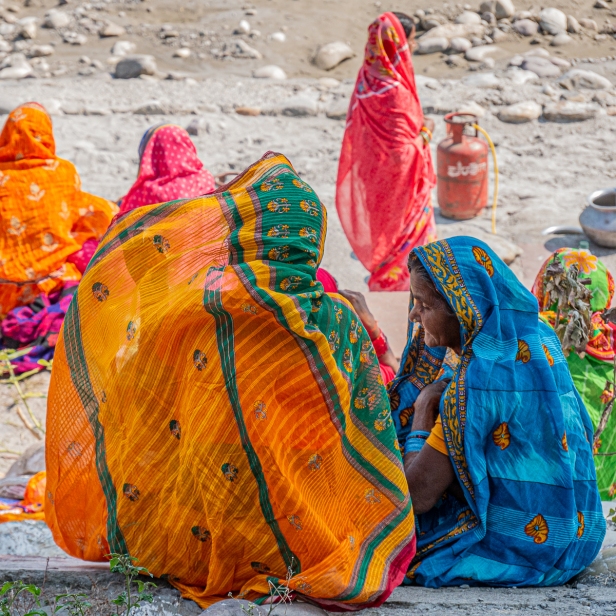

this brilliant country that is some kind of irregular improbable jigsaw of hundreds of different tribes and cultures, is going through one of the worst times in its history brought into sharp relief by the corona virus pandemic.
According to Guha: The Indian medical system is overburdened; the Indian economy is in a shambles; Indian society is divided and fragile; Indian federalism is weaker than before; the Indian State is becoming increasingly authoritarian — it is the combination of all these factors that makes this perhaps the greatest crisis the country has faced since Partition.
Narendra Modi, the prime minister, gave four hours notice for the lockdown. Four hours! Without consideration for the millions of migrant workers who had to get back to their homes, often hundreds of miles away. The people did the only thing they could. They began walking – with no food no money no support. Eventually, after a couple of days, transport was allowed to run again to get these people home, though of course they are now unemployed. Unemployment has risen from 7% to 27%.
We have friends in Rishikesh who lost their jobs as servers in a restaurant because of the lockdown. They had a couple of days of panic trying to get back to their village in the Himalayan foothills. Each with a wife and child, they eventually managed to scramble onto an inevitably overcrowded bus and get home. We sent them money. There is no bank in their village. We don’t know if they can access it or not but it is there for them when they can. They send texts to Don every few days. They call him their father and me Ma’am-ji. We are moved by every text and photo we receive from them. They are such good people, and we are so happy to see they are in a green rural setting and seem to be healthy. They are among the lucky ones.
The once busy and overcrowded streets of Rishikesh
are mostly empty these days. The tourists, both international and domestic, have left long ago. With what is being called Stage 4 of the lockdown some businesses are now starting to open again, but not yet the restaurants. The auto rickshaws are running again but can carry only two people instead of the usual (or at least hoped-for) ten.
The number of new cases of Covid-19 continues to rise in India by about 5% per day so it is far from over, but there are no known cases in Rishikesh, and India’s total deaths from the virus sits at 4980, a remarkable statistic given it’s such a crowded country with a chronically overburdened medical system.
So now I want to take you back to an earlier time. It was only three months ago, but feels like a lifetime. I got sick in India, the usual parasite/bacteria/gut problems. I found a clinic where I could see a doctor just down the street from the ashram that we were attending each morning. The street
is an artery through a quiet residential neighbourhood,

and as I waited in the morning for the clinic to open I watched the community come alive with beginning-of-the-day activities, the rush to get to schools and jobs. This is what it looked like then:
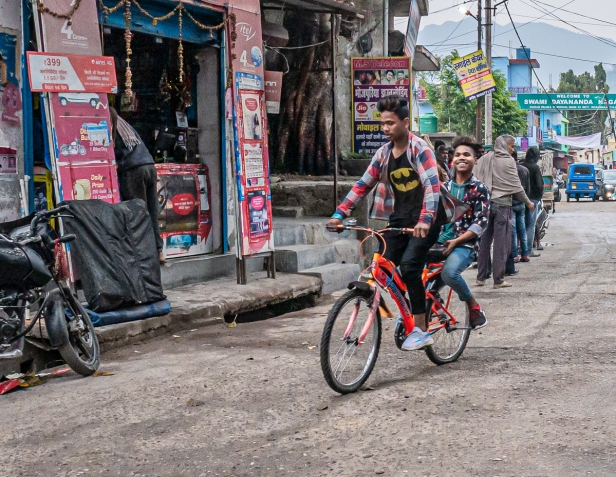








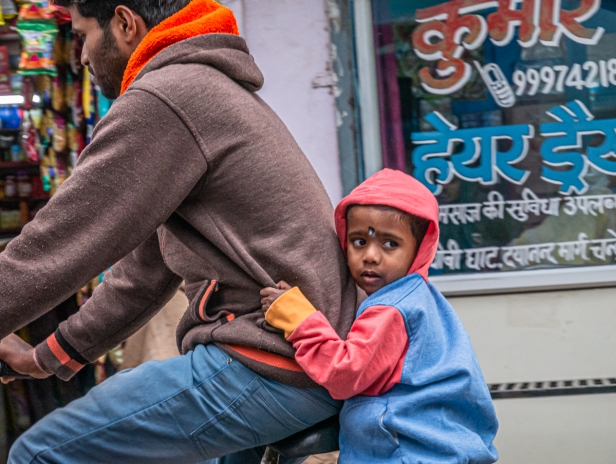
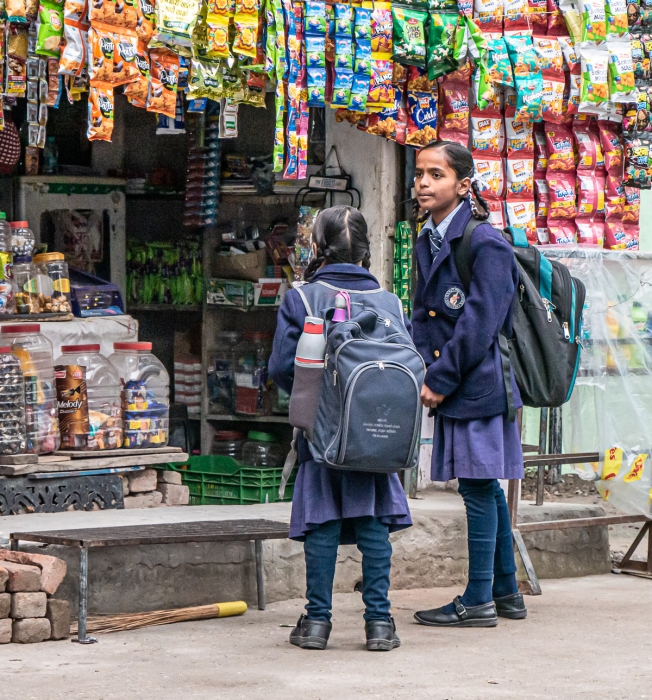

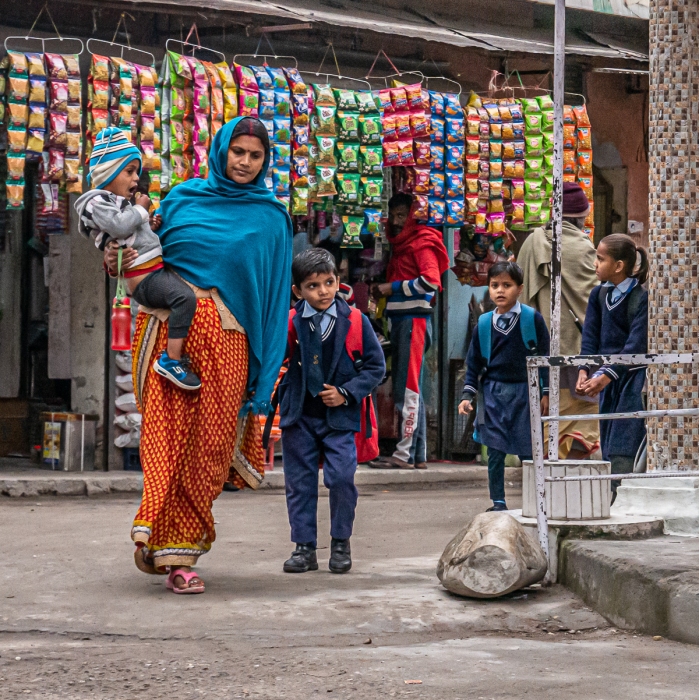
With a few twists and turns down this road you’ll come to the main road that runs north-south through Rishikesh. It’s largely empty these days, but back in February when we were there you could get a tuk tuk all the way up to the Tapovan area in the northern part of the town. A walk through Tapovan, first on streets and then on ever-narrowing alleys brings you to Lakshman Jhula.
If, instead of going down the stairs and crossing the bridge you turn left past the German Bakery, follow the road along by the river, make a couple of turns, and go down some very narrow alleys in a different residential area, you will eventually come to this: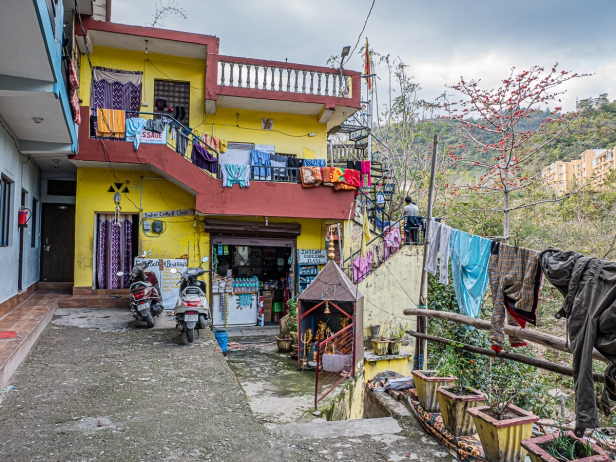
If you then head down the narrow staircase right in front of you, past the shed housing the milk cows, you will come to Ramana’s Garden Organic Café, and Ramana’s Garden School. The school, begun more than 20 years ago by an American woman, Prabhavati Dwabha, provides free primary and junior education to nearly 200 students as well as housing nearly 70 at-risk children. The café, run entirely by volunteers and catering largely to western tourists, is one of their main sources of income. It serves the best homemade lasagne and ravioli I’ve ever eaten, but the loveliest thing about eating at Ramana’s Garden café is sitting outside on the middle-level deck right next to the flowering Silk Cotton tree. Several times we were lucky enough to get that table and were entertained by a parade of exotic birds as we waited for our meal.
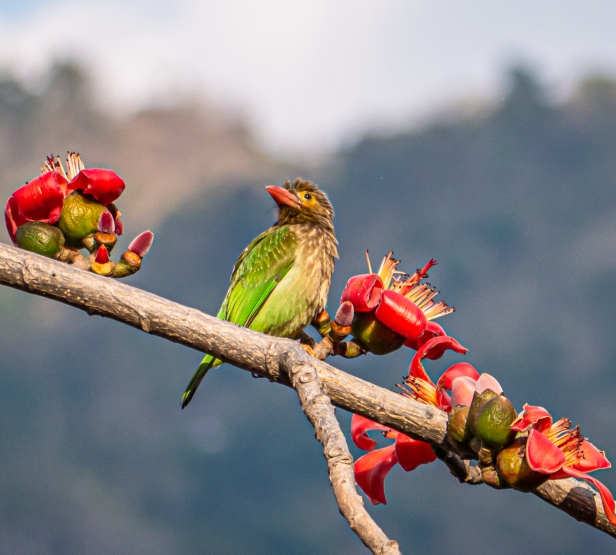


And walking home alongside the river one day we saw a pair of Great Hornbills!

Instead of diving into garbage bins,
or swiping bananas from a fruit stand,
I’m guessing the langurs

along with the macaques

have headed off into the forest to fend for themselves with the closure of easy pickings in town.
After having been sick for nearly two weeks the doctor prescribed some medications that cured me in three days for a total cost of about $5. The café at Ramana’s Garden closes anyway in March so the lockdown would not have affected it too much. The children that live at the school no doubt stayed in place. And Rishikesh is slowly opening back up again.
I’ll close with something from Madhu who writes at The Urge To Wander: Most people outside of the country do not quite grasp the miracle that is India. This gaggle of disparate cultures, religions, languages and notoriously rule-breaking citizens who’ve managed to stay together despite some of the most corrupt & inefficient of systems anywhere.
And I hope with all my heart that the same miracle will help India pull through this latest round of challenges, and that one day soon children will again put on their uniforms and head off to school.
Next post: Back to Vancouver summer 2019 – the Pride Parade and the Columbia Street (food truck) Festival.
All words and images by Alison Louise Armstrong unless otherwise noted
© Alison Louise Armstrong and Adventures in Wonderland – a pilgrimage of the heart, 2010-2020.

Stunning, colourful pictures!
Linda
LikeLiked by 1 person
Thank you. I miss India.
Alison
LikeLike
Your love shows in your captures and the mindfulness of your narrative Alison…the cow and the little wee one on the bike…makes me smile. Thank you ~ hugs Hedy ☺️☀️🙋♀️🤗
LikeLiked by 1 person
Thank you so much Hedy. Both Don and I were looking at the pictures and missing India. I can’t imagine it will survive unscathed, but no doubt survive it will. Things will change because they have to. Hopefully for the better. I’m glad for inciting smiles 🙂
Alison ❤
LikeLike
Beautiful photos. Heartbreaking to think of what is happening to India and so many other poor countries. I hope your friends survive this intact.
LikeLiked by 1 person
Thanks so much Kay. I have a feeling our friends will be fine. I hope I’m right. Rishikesh and area seems to be blessed so far. There are several countries that still have a quite high daily percentage of increase in the number of cases. India is one of them. (Bangladesh, Brazil, Chile, Mexico, Pakistan, etc). This is far from over. What a time we’re living in. I think every country will be changed by this.
Alison
LikeLike
Heartbreaking and beautiful Alison.
LikeLiked by 1 person
Thanks so much Cindy. Yes heartbreaking, but I have hope for a renewed future, especially for Rishikesh.
Alison
LikeLike
It is for me always a pleasure to see this kind of documental photographies 🙂 all the best, PedroL
LikeLiked by 1 person
Thank you so much PedroL. Sometimes it’s best to let the pictures do the talking isn’t it.
Cheers, Alison
LikeLike
Oh yes it is 🙂 PedroL
LikeLiked by 1 person
Excellent street photography and cute animals.
LikeLiked by 1 person
Thanks so much rabirius. I think one of my favourite travelling activities is to stay in one place on a busy street and photograph what passes in front of me. It’s always interesting.
Alison
LikeLiked by 1 person
The photos makes one forget the pain and squalor. India is a mess at present and no one knows how and when it will be alright. Indians love to blame the next person little realising it is a cumulative contribution to the mess. The Covid cases are piling up due to apathy, corruption, fear and the unexpectedness. No one had anticipated the migrant exodus and now we are looking for solutions.
LikeLiked by 1 person
I kind of gathered it’s not good there from what I’ve been reading, and watching the number of cases increasing daily. I do hope you find solutions – meaning the people of India on both an individual and governmental level. I imagine, like other countries, some states/areas will do better than others. But, yeah, it’s a mess with no quick fixes.
I hope you’re well and safe.
Alison
LikeLiked by 1 person
Thanks Alison….take care
LikeLiked by 1 person
This post makes me feel so sad. We have Mendelssohn’s violin concerto playing which does not help – but it’s the same – beauty and pain, a wistfulness, a longing. A need for hope. Sometimes it’s quite hard not to feel engulfed by all that is happening at the moment.
LikeLiked by 1 person
Oh I know what you mean. Probably Mendelssohn doesn’t help, but the upheaval happening everywhere can’t be ignored, and it’s inevitably worse in places like India. Also Bangladesh and Pakistan. Interestingly many African countries are doing incredibly well because they’ve had epidemics there before and knew immediately what needed to be done and everyone complied.
This too. This too. I think we must not let it bury us. I conscientiously focus on all the silver linings – the improvement in the environment, and all the ways people are helping each other, all the small, and large kindnesses that are arising as a result of the upheaval. I continue to believe that people are basically good.
Alison
LikeLiked by 1 person
I too concentrate on the good, the quirky, and inherently belief we’ll get through this and come out better, but every now and again it’s just too much. But I loved the everyday in your post, the normality, and all the little gems of goodness. And sometimes it’s good to feel like this. If you’re always up, you’re never up! Thanks Alison.
LikeLiked by 1 person
Yes, that’s so true, and a great way to put it – if you’re always up you’re never up.
LikeLike
Your words and images and love shine through this entire post. Thank you. ❤
LikeLiked by 2 people
Thanks so much Louise. My pleasure. Putting this post together made both Don and me realize that we miss India. There is nowhere like it.
Alison
LikeLike
Such a moving post Alison, and wonderful photos as always. It’s terrible how difficult it is there for so many, hoping they, like everyone else, will pull through.
LikeLiked by 1 person
Thanks Amanda. I can only go by what I read, but I think it’s going to be pretty bad for much of India for a while, and I know I shouldn’t play favourites but I’m glad that Rishikesh seems to be safe. And I remain eternally optimistic. People are so infinitely resourceful.
Alison
LikeLiked by 1 person
Lovely and moving post, Alison, which brings home something I love about visiting here: the view of humanity that transcends nations. It’s really just people everywhere, isn’t it? The happiness and hope we’re able to find, despite relative conditions. The destitution and doubt. The hope. I loved the pictures of morning breaking loose in Rishikesh. The children smiling and adapting and thriving in the world that is theirs, dreaming off camera perhaps, of what their lives will offer. It takes but one photo of a smiling person to show the value of thinking about the value of life everywhere, a value that cannot be quantified…
Peace
Michael
LikeLiked by 1 person
Thank you so much Michael. There are many things that inspire me to travel, but the truth that humanity transcends nations is one of the most compelling. I love wilderness and wildlife, and beauteous landscapes, and historic sites, and stunning manmade creations, but always for me it’s the people that make a place. I’m afraid I’m quite unconscionably nosy – I want to know how people live, how they make life work. I’m continually *still* amazed by human creativity. So yes, it really is just people, the same everywhere, all trying to make it work somehow. Full of the same hopes, dreams, fears and doubts. And every life has value, every one sacred. We forget this, but even that is part of the play. I think underneath every one of us knows the infinite sanctity of life, even if we don’t consciously know it.
Alison
LikeLike
Alison. No words. You have said it all. Louise x
LikeLiked by 1 person
Thanks Louise. I remain relentlessly optimistic. Indians are nothing if not resilient.
Alison
LikeLiked by 1 person
Wow incredible! An artistic organized chaos where life moves and humans live with animals! Can’t wait to explore India!
LikeLiked by 1 person
Thanks! India is just amazing. We’ve been four times over the years, each time for up to three months. It’ll blow your mind. Hope you make it one day!
Alison
LikeLike
A very authentic article on India. It’s true that some parts of the country is unconsciously dressed like a colorful carnival that celebrates the various shades of life with every passing minute, inspite of battling enormous vicissitudes almost daily. Life is a struggle for most, but there is beauty, charm and poetry in its hindered flow. Faith commands many souls in this ancient land to look for enlightenment. It’s a land that embraces all and discards none.
LikeLiked by 3 people
Thank you so much for your kind words brihaad. It means a great deal to me that an Indian would confirm that I have authentically captured India. I’ve spent several months over the years in your country and love it very much, despite, or perhaps because of the struggle that is interlaced with so much beauty, so much caring, so much love. I agree that India embraces all and discards none. It’s a very special place and I hope for a brighter future for everyone.
Alison
LikeLiked by 1 person
You have made a very impartial assessment of things. India has embraced you too. The pitfalls are enormous here, but inspite of it there is an irresistible beauty in its bewitching charm. The current scenario is definitely not so conducive to the culture that was harnessed and nurtured for centuries. I think India is beyond religion and an attempt to saffronize it, will rob it of its unique identity. Here Churches go on a joy ride with Temples and Mosques. Any attempt to undermine this harmony will threaten its identity.
India is the land of Adi Shankara, Saint Thomas and Moinuddin Chisti. That is who we are.
Thanks Mam.
Please visit again.
Ranadeb
LikeLiked by 3 people
I have posted a new piece last night. The second part will be posted today. Kindly take some time out to read the same . Please provide your feedback on it, if you can.
LikeLiked by 1 person
An interesting and insightful view of a county experiencing difficult times (sadly like many other countries, given the global landscape), amidst a turning point within humanity. Many. many more changes on every level will continue to unfold, beginning at a personal level and a greater awareness of each individuals responsibility and their personal contribution to humanity.
LikeLiked by 1 person
Thank you for your thoughtful comment Marilyn. I agree this is a turning point, and much needed however painful. We are all being challenged to dig a little deeper. May we have the strength and resilience we need. Each one of us has a part to play however small. Each one of us has a heart to be broken open.
Alison
LikeLike
Your photography is so amazing Alison. Thanks for sharing.
May you, Don, and we one day get back to India.
Cheers,
David
LikeLiked by 1 person
Thank you so much David. I’ve been looking back at some earlier posts and I will at least own that I’m getting better at it.
Oh yes, I hope for all of us, and for India (may she be healed enough) that we can get back there one day.
Alison
LikeLike
Alison, thank you for this description of Rishikesh now and in February. Love your street portraits of kids in school uniform as well as all the wildlife. Great that you had proximity to those two hornbills!
If our repeated trips to India have taught us anything, is that the country and the people have a remarkable ability to weather and adapt and shift as needed, to survive crises. This is not to say, without enormous human toll, rather, in concert with absorbing extraordinary human toll.
What is disturbing to us is that in addition to all the crises identified by the historian you mention, is that there is also an external geopolitical reality which is that China is feeling emboldened and China’s wolf diplomacy of aggressive expansionism in all of South East Asia, could create an additional layer of existential threat if China decides to pick this moment to mess with India either by stimulating conflict on the Pakistani/Indian border, or by over reaching into India’s North Eastern territories of Arunachal Pradesh and Assam.
Climate change is another macro threat as we just saw in last weeks Amchan cyclone that created havoc and devastation in West Bengal as well as Bangladesh.
Challenging days for India….
Ben
LikeLiked by 1 person
Thanks so much Ben. I completely agree with your second paragraph. It is the reason I still feel hopeful, optimistic. Things change but people are enormously resilient and creative. We see this everywhere we go and it still moves me the way people find ways to make life work even in the face of enormous hardship. And yes, I agree that China could be a problem (let’s hope not) and that climate change could after all the biggest crisis of all. I actually think it is, for everyone, and as we’ve already seen it’s not going to spare India. And in the face of all this I still have faith in humanity, in compassion, in love.
Alison
LikeLike
Are these all of your own photos? They are fantastic. I truly wish the good people of these deprived countries find peace soon.
LikeLiked by 1 person
Thank you so much Christine, yes they are all my own photos. I too hope for peace for the people of India, and for all. We live in challenging times.
Alison
LikeLiked by 1 person
I remember telling Madhu how similar our countries are; both India and Indonesia have huge population, and are incredibly diverse, very corrupt, chaotic as well as inefficient. However, on the other hand, both are endlessly captivating, blessed with beautiful nature, and home to rich and unique cultures. India and Indonesia are the world’s largest and third largest democracies, respectively, so it is my dream that both countries can work more closely together to nurture democracy in Asia where a powerful, authoritarian giant is increasingly flexing its muscles and bullying its neighbors. Unfortunately, both India and Indonesia are too busy dealing with their internal problems at the moment.
LikeLiked by 1 person
Clearly both countries have a lot to deal with at the moment. More than usual obviously. And the threat from China must be very worrying. I’d love to visit Indonesia one day. I’m sure I’ll find it captivating – so many different islands and cultures to experience! I had no idea it’s the 3rd largest democracy.
Alison
LikeLiked by 1 person
Beautiful photos as always Alison. Such a heartbreaking situation in so many parts of the world that we’ve visited. Thank you for sharing your love of India.
LikeLiked by 1 person
Thanks so much Danila. It is heart breaking. On the other hand the good news is that the percentage increase in the number of new cases in India is lower than a couple of days ago. India will come through this. One way or another. I think Pakistan and Bangladesh are struggling a bit, but SE Asian countries are generally doing very well.
Alison
LikeLike
Your intimate photos of Rishikesh bring the place to life. The entire world is changing far more rapidly than we could ever imagine…how each of us adjusts and continues forward in treating one another will dictate how our societies survive this.
LikeLiked by 1 person
Thanks so much Atreyee. I loved that morning on that ordinary urban street watching as it came to life for the day.
I am hopeful for the future still. It seems to me that many people have been taking a deeper look at themselves and their life, though I don’t know if that is true in India or not. I hope so anyway. I hope for us, all of us, to come out of this time less fractured and more supportive of each other as a community, as a common unity.
Alison
LikeLiked by 1 person
In some ways, I think resilient places like India will survive the Covid crisis better than some of the better-developed countries, like the U.S., that can’t even buckle down and handle a few months of abnormal times. Your posts on Rishikesh always radiate your affection for this special place, and the views of what was and what likely is going on there right now make for a compelling read once again.
LikeLiked by 1 person
Thanks so much Lexie. I do love India, and especially Rishikesh (and Varanasi – my equal favourite Indian city). There’s something so invigorating about it – the way the people are, the way they cope, the colour, and the amazing welcoming friendliness of just about everyone. There was a woman on a crowded ferry crossing the river one day and she was talking to her mom on her phone so she introduced me to her mom over the phone! They just welcome everyone in like it’s normal. Unlike the more cautious west. I think you are right – they will weather the storms better because they have had more experience of hardship and surrender and developing ingenuity to make things work and a deeply ingrained sense of supporting each other and everyone working together. Ah just writing this makes me miss it a little, though I’m aware of how lucky I am to be in my safe little bubble here in Vancouver.
Stay safe.
Alison
LikeLiked by 2 people
all picures are greaT
LikeLiked by 1 person
Thank you so much.
Alison
LikeLike
Great article and pictures guys. Absolutely amazing
LikeLiked by 1 person
Thank you so much. I’m glad you enjoyed it.
Alison
LikeLike
Alison, thank you for sharing these beautiful memories of Rishikesh. I’ve been struggling with what to write over these past few months, and figuring out how to strike the right note in these troubled times. But now you’ve given me an answer. This is such a hopeful post that doesn’t shy away from current realities – and yet your love for the miracle that is India and its people really does shine through.
Among all the portraits of residents (and wildlife) going about their daily lives, what stood out for me most were the two photos of a child holding onto the sweater of their parents, and then the mother langur blithely eating the stolen bananas as her infant clung to her… it really brought into sharp focus the fact that we share so much of our DNA with other primates. And the shots of those birds, the hornbills especially, brought a smile to my face. Let’s hope we humans treat nature with the respect it deserves as we all emerge from lockdown.
LikeLiked by 1 person
Thanks so much James. Any post that brings a smile is a win for me. The hornbills were definitely serendipity. Don and I were just walking home lost in our own little world as usual and would have missed them entirely if there had not been other people who had spotted them.
I do love India, and I am hopeful. They are such resilient people and will perhaps do better because they are not pampered but rather know well how to weather hardship with some measure of equanimity.
I too hope we will emerge from this pandemic with better respect for nature and the planet. I certainly believe at least some will have reassessed their lives for the good.
I’m glad I’ve given you an idea for how to proceed with your blog, as you have inspired me in the past. I think I’m a better writer now that I was because of reading your blog, and getting some ideas of how to write posts.
Alison
LikeLiked by 1 person
Alison – so beautifully-wrtten and heartfelt. It’s the whole reason to get out and see the world- to be a part of the human event of living regular lives all over the planet. Wonderful reading! Thanks – Susan
LikeLiked by 1 person
Thank you so much Susan. I’m so glad I was able to convey a bit of what it’s like there. It’s all just people, wherever we go, all doing their best at what for them is ordinary life.
Thank you for your lovely compliment!
Alison
LikeLiked by 1 person
It’s hard to imagine the relatively low number of deaths in India from Covid-19 in comparison to the number of deaths in the US, Alison. I fervently hope the other shoe won’t drop in India. As always, thanks for your thoughtful insights and stirring photos. –Curt
LikeLiked by 1 person
Thanks so much Curt, and you’re welcome. After all these years I still enjoy putting blog posts together.
The number of dead from Covid-19 in India goes up daily, but is still only at 7200, a truly remarkable number given their circumstances. I too hope the other shoe doesn’t drop!
Alison
LikeLike
Covid-19 certainly isn’t done, Alison. I’ll rest more easily when a vaccine is developed and out. I’ll be first in line. Sometimes the work of blogging gets a little much but I still enjoy it as well after ten years. –Curt
LikeLiked by 1 person
Me too ten years! Amazing really. Well done us!
A.
LikeLike
Once again you have done a great job of capturing the heart of India. It’s really amazing there aren’t more cases. I met a young man, Rahul, on the street in Bodh Gaya. We talked all of 10 minutes but became Facebook friends. Now I follow him as he goes weekly to different villages in the area to deliver packets of food. The villages have between 100 and 200 residents and each family gets enough food for a week. He’s gotten support from his many friends abroad who are inspired by his generosity and determination to help others. A remarkable young man.
LikeLiked by 1 person
Thanks so much Jane. I agree it’s amazing they don’t have more cases. They still have less dead from the virus than Canada! I love the story of Rahul, a remarkable young man indeed. It is this kind of caring and kindness that always moves me in the face of difficulties and tragedy. I think India will pull through.
Alison
LikeLike
Like James mentions above, your ability to show the current reality of India , as well as the beauty of the normal, leaves me thinking that perhaps this is the way to present destinations in travel writing. Your photos as always make me think I have flipped open a National Geographic magazine. They transport me to this amazing world which we have not yet visited. In this current time, I can not yet dream it. For now I shall join you in hoping that hose living there can return to some sense of normalcy soon.
LikeLiked by 1 person
Thanks so much Sue for all your lovely compliments and kind words. Nat Geo eh! Thank you! I really wanted to share about our time in Rishikesh but just couldn’t without referencing the present. I’m hopeful for India. Well, I’m just an old Pollyanna really – I’m hopeful for all of us.
Alison
LikeLiked by 1 person
This is a beautiful portrait of Rishikesh. I can feel your love for the place through your exquisite words and photos. It’s tragic that countries like India that already have so many challenges are now faced with more hardship.
Having lived my entire charmed life in Canada, I’m always astounded how despite poverty and struggles, places like Rishikesh have such rich, colourful culture. I love that “flowers are an industry of major importance”.
LikeLiked by 1 person
Thank you so much Caroline. Rishikesh is indeed a place we love very much. There is a joy and a sacredness there despite the hardships the people face. It’s been the same everywhere we’ve been in India, but for me Rishikesh and Varanasi are truly special.
I too am always amazed by the way people find joy and happiness even in the most dire circumstances. People find their resilience in places like India. We lucky ones in Canada and the like are not even tested. (I could segue here into a rant about people complaining that they can’t get a haircut but will refrain 🙂 )
Alison
LikeLike
I am impressed by your wise words about India and inspired by your insight in humankind. Your photos are stunning, as usual. I especially like the cow standing in the doorway, no words needed.
LikeLiked by 1 person
Thanks so much Astrid for your kind words. I really enjoyed the morning on the residential street where I could just watch and document the people going by. It gave me such a good insight into their daily lives, especially all the kids going off to school. As for the cow – that was an opportunity too good to miss – so quintessentially Indian!
Alison
LikeLike
Such a beautiful, sensitive post Alison. Your fondness for my country shines through this post and your photos capture unadulterated life so brilliantly. The woman in the peach sari with her son tugging at her sweater, juxtaposed against the hair dressers sign board is a standout for me. She doesn’t appear to be one, but her purposeful stride brought to mind the heartrending visuals of the long lines of migrant workers walking back to their home states.
The magic that is India was already under threat, this pandemic feels like a death blow. The number of deaths might be lower than other countries, but the numbers of livelihoods devastated is likely way, way more. And the authorities are yet to come out with concrete welfare measures. Citizens have been doing the best they can to help but the scale is too vast for that to make enough of a difference. We can only hope for better times. Thank you for this lovely, hopeful piece. And for the link back.
Stay well.
LikeLiked by 1 person
Thank you so much Madhu. I loved this time on this ordinary urban street where I could just watch the people going about their day. When I was getting the photos together for this post both Don and commented on how looking at them made us miss India. You do live in an extraordinary country, but I’m sure you know this.
I saw pictures of the migrant workers – so heartbreaking, as is your prognosis. I just hope and hope and hope that somehow India will pull through, that enough people will give enough help until bit by bit every one can get back on their feet again.
We heard from our friends from Rishikesh – they have heard that the restaurant will not open again because the owner was renting the space and has lost it now – just one of the millions of casualties of the pandemic. But our friends, still in their village, are safe and well. And people are resilient. I think of that restaurant – it’s already has all the equipment to operate as a restaurant. Surely someone someday will start it up again. Hopefully the country will grow again on all these small steps.
Stay well Madhu. All the best to you.
Alison
LikeLike
Love your photos of the children. And the monkeys are amazing. I’ve saved the cafe to my google map. I hope to eat there one day. 🙂
LikeLiked by 1 person
Thanks so much Peggy. The monkeys are everywhere! So comical, but we’re always sure to keep our distance – they can be a bit aggressive sometimes though we’ve never had any problem with them.
Ramana’s Garden Cafe is wonderful. I too hope you get to eat there one day!
Alison
LikeLiked by 1 person